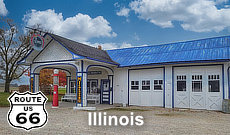 Route 66 Road Trip on Facebook
Route 66 Road Trip on Facebook
Welcome to the historic Route 66, also known as "The Mother Road"! This iconic highway holds a special place in American history and culture. Established on November 11, 1926, Route 66 stretched 2,448 miles from Chicago to Los Angeles. It became a lifeline for those migrating westward and played a significant role in connecting the Midwest with the Pacific Coast.
The Early Years
During its early years, Route 66 was a mix of paved and unpaved sections. It took 11 years until the entire road was paved. Travelers embarked on their journey from Chicago, heading southwest through Illinois, Missouri, and a small section of southeast Kansas. From there, the road turned westward, passing through Oklahoma, Texas, New Mexico, and Arizona before reaching its final destination in Los Angeles.
 The Dust Bowl Migration on Route 66
The Dust Bowl Migration on Route 66
In the 1930s, during the Dust Bowl era, Route 66 became the main route for farmworkers migrating from the Midwest to California in search of better opportunities. The road also served as a vital transportation route for military equipment during World War II. Its flat terrain and moderate weather made it an attractive choice for travelers and truckers alike.
Growth and Development
Route 66 gained popularity in the 1950s as the main highway for vacationers heading to Los Angeles. The increased traffic along the route led to the opening of numerous "mom and pop" restaurants, motels, and service stations to cater to the needs of travelers. The United States Highway 66 Association played a significant role in promoting and paving the entire highway by 1938.
Changes and End of an Era
Route 66 experienced several realignments and improvements over the years to accommodate the growing demand for better highways. However, its final demise came with the completion of the Interstate Highway System. The last town bypassed by the Interstate was Williams, Arizona, on October 13, 1984. Eventually, on June 27, 1985, Route 66 was officially removed from the United States Highway System. It was replaced by a network of interstates such as I-55, I-44, I-40, I-15, and I-10.
Route 66 Today
 Touring Route 66 in Your Own Classic Chevrolet Corvette
Touring Route 66 in Your Own Classic Chevrolet Corvette
Despite its official closure, Route 66 remains a major tourist attraction, beloved by travelers from around the world. Many states have recognized its historical significance and marked it with "66" in their state highway numbers. "Historic Route 66 Associations" are active in several states, dedicated to preserving the history and legacy of this iconic road.
Today, you can still traverse dozens of small towns along the old road, filled with vintage gas stations, quirky roadside attractions, diners, "mom and pop" motels, and historic sites. Whether you choose to explore Route 66 by car, bus, RV, or motorcycle, the experience is bound to be unforgettable.
Centennial Celebrations
In 2026, America will celebrate the Route 66 Centennial, marking 100 years since its inception. Plans for special events and tours are already underway to honor the Mother Road's rich history. It's an excellent opportunity to embark on your own Route 66 adventure and be a part of this historic milestone.
We hope that this article has inspired you to include Route 66 on your bucket list of destinations. Prepare for an unforgettable journey filled with nostalgia, stunning landscapes, and the spirit of adventure. Get ready to experience the charm and allure of the Main Street of America!

















